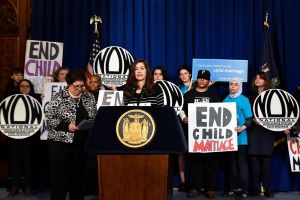By Maniza Habib
On April 4, the state legislature in Virginia voted to amend state law, raising the marriage age to 18. A couple of days later, Governor Glenn Youngkin signed this measure into law.
Coming amid Sexual Assault Awareness Month in the US, this vote was an important victory for child rights. Protecting vulnerable minors from sexual assault ought to include banning child marriage across the United States. But Virginia is only the 12th US state to ban child marriage. The other 11 enacted their bans between 2017 and 2024. This means that until the year 2017, child marriage was legal across the US under certain conditions: if the parents or a judge consented, or if the minor was pregnant or had a child. These loopholes effectively kept the practice widespread.
Just 12 states out of 50 having a ban on child marriage is a shamefully low number. Much more needs to be done. We need to ban child marriage nationwide.
Though Americans often view it as a “foreign” problem, child marriage is surprisingly widespread throughout the US, cutting across different regions, religions, and cultures, according to a new Population Institute study titled Behind Closed Doors: Exposing and Addressing Harmful Gender-Based Practices in the United States. Between 2000 and 2018, an estimated 300,000 minors under age 18 were legally married in the US. California, for example, does not specify any minimum age for marriage, and more than 8,000 children are married there each year.
Eighty-six percent of child marriages reported in the US took place between adults and minors, most often girls ages 16 to 17, but sometimes as young as 12. Marrying them to adult men sets up a dangerously imbalanced power dynamic that raises the risk of domestic and sexual violence.
To be clear, child marriage is a form of gender-based violence and a human rights violation. In addition to physical and emotional abuse, it puts minors at higher risk for poverty and exploitation. And denies them educational and economic opportunities. It is the leading cause of adolescent girls dropping out of school worldwide. In the US, women who marry before age 19 are 50 percent more likely to drop out of high school. Four times less likely to graduate from college, and 31 percent more likely to live in poverty. The consequences reverberate throughout their lives, perpetuating cycles of intergenerational poverty.
But since there is no comprehensive federal law setting a minimum age of marriage, and the patchwork of state child marriage laws is inconsistent and riddled with loopholes, the practice persists. The myth of American exceptionalism, the contrary-to-fact belief that child marriage is someone else’s problem and that it can’t happen here, blocks constructive public discussions and effective legislation.
This misguided belief fuels a cycle of neglect and inaction that keeps states from passing effective measures.
Resistance to enacting child marriage bans also comes from both conservative and progressive groups. Conservatives argue it would interfere with religious freedom. Progressives worry it could take sexual and reproductive choice away from minors.
But child marriage threatens the bodily autonomy and reproductive freedom of a child more than any ban ever could. Ending it is more important to the health and dignity of American children than preserving antiquated traditions. They need protection from entering legal contracts that they do not have the power to escape. And empowerment to make their own choices about their lives.
While the US has vocally opposed child and forced marriage in other countries, laws against it inside the US are patchy, weak, and fail to protect those at risk. In fact, most US states are overwhelmingly noncompliant with international child rights standards.
Ending child marriage in the US will first require recognizing it as an urgent, ongoing, domestic problem. Further stigmatizing the practice or ostracizing affected communities will not help. US policymakers should focus on learning from survivors to understand child marriage’s root causes and real impacts. And work with them to build support for child marriage bans in each state.
Survivor-led advocacy goals include raising awareness, passing effective, implementable legislation, investing in comprehensive sexuality education, and expanding reproductive health support services and resources. State authorities should support such efforts.
All states should work to pass and implement a strong legislative framework setting the minimum age of marriage at 18, with no exceptions. That is the only way to ensure full and free consent. It is incumbent upon policymakers, advocates, and community members to stand up against child marriage and other harmful gender-based practices, and to uphold everyone’s fundamental right to bodily autonomy and dignity.
Written by Maniza Habib
Research Associate at the Population Institute
The views expressed in this article are the author’s own and do not necessarily reflect IVNTV NEWS editorial stance.
First published by Al Jazeera
![]()

